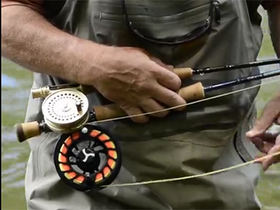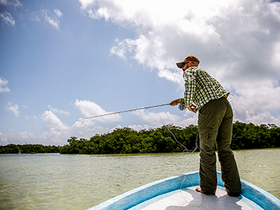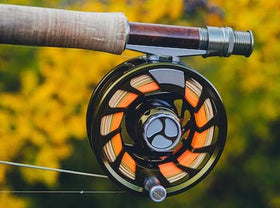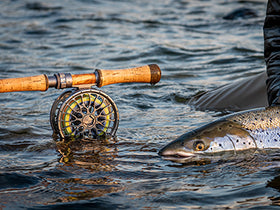How to Choose the Right Fly Line
Buying the correct fly line is one of the most crucial decisions in fly fishing. Your line affects everything—from how far you cast to how naturally your fly lands on the water—ultimately determining your success on the water.
At The Flyfisher, we’ve been helping anglers find the perfect fly line since 1967. With so many options available, understanding the differences between fly lines is key to selecting the right one.,
We explore six key factors to consider when choosing a fly line by drawing on expert insights. Our team has analysed the content from our podcasts with Rene Vaz of Airflo and Andrew Summers from Scientific Anglers. Both are industry veterans with decades of experience, offering practical advice to help you make an informed decision.
1. Types of Fly Lines: Understanding the Basics
Fly lines come in different types, each designed for specific fishing environments and techniques. Floating, sinking, and intermediate lines are the three main categories, but within each, there are numerous variations when considering how to choose a fly line. Some popular leading fly line brands include Scientific Anglers, Airflo, RIO and Cortland.
Fly lines vary in taper, material, and coating, impacting their performance in different conditions. Floating lines are ideal for dry flies, while sinking lines help target fish in deeper water. Intermediate lines offer a balance for fishing just beneath the surface. Understanding these differences is vital for matching your fly line to your fishing style and target species.
Consider the following types to narrow your search:
1. Floating Fly Lines: Best for topwater presentations, dry flies, and general-purpose fishing.
2. Sinking Fly Lines: Effective for deepwater species, especially in still waters and fast-moving rivers.
3. Intermediate Fly Lines: Great for subsurface fishing, particularly in saltwater flats and lakes.
Expert Tip: Rene Vaz from Manic Tackle Project emphasises that matching your fly line to the conditions you’re fishing in is key to success. His recommendation? Test different lines in various environments to discover which works best for your specific needs.
2. Matching Your Line to Your Rod and Fishing Style
Choosing the right line isn’t just about the water you’re fishing—it’s also about the rod you’re using and the style of fishing you prefer. The weight and taper of your line should complement your rod to maximise casting efficiency and presentation accuracy.
For example, fast-action rods typically perform better with heavier lines that load the rod more quickly, while slower-action rods benefit from lighter, more delicate lines. It’s also important to consider your casting style. If you’re a technical caster focused on accuracy, a line with a longer, gradual taper might be ideal. On the other hand, flyfishers targeting fast-moving fish may prefer a line that loads quickly for speed and power.
Make sure to consider:
• Rod Compatibility: Ensure your line weight matches your rod for optimal performance.
• Casting Styles: Select a taper that suits your casting technique—shorter tapers for quick loading, longer tapers for distance and accuracy.
Expert Tip: According to Simon Gawesworth from RIO Products, matching your line weight to your rod is crucial. He suggests trying out different combinations until you find the perfect balance for your specific casting style.
3. Specialty Fly Lines for Unique Conditions
Fly fishers often encounter unique conditions that require specialty lines. Whether you’re targeting barramundi in tropical estuaries or trout in high-altitude alpine streams, selecting a line designed for the environment can significantly improve your chances of success.
Coldwater lines maintain flexibility in low temperatures, making them ideal for winter fishing. Conversely, tropical lines are stiffer and coated to withstand high temperatures and saltwater environments. Specialty lines for specific species or environments are engineered to enhance performance in those conditions, such as:
• Coldwater Lines: Retain flexibility in cold temperatures, ideal for winter fishing or general trout fishing.
• Tropical Lines: Designed to handle the heat, these lines resist the wilting effects of high temperatures.
• Species-Specific Lines: Tailored for particular species, such as bonefish lines for saltwater flats or bass lines for warm water environments.
Expert Tip: Rene Vaz from Manic Tackle Project suggests considering the specific conditions of your next fishing destination when selecting your line. Specialty lines can make a noticeable difference in challenging environments.
4. Key Factors to Consider When Choosing a Fly Line
When choosing a fly line, you need to think beyond just the basics of floating or sinking. Factors like taper design, line weight, and coating will impact your line's performance. Different manufacturers offer unique features, so it’s essential to consider the specific characteristics of each brand.
For example, some lines have advanced coatings that reduce friction and improve casting distance, while others may offer enhanced durability for fishing in rocky conditions. Additionally, the taper design can significantly impact your ability to cast long distances or present your fly delicately. Understanding these details can help you make an informed decision when selecting your next fly line.
Three key factors to keep in mind are:
1. Line Coatings: Advanced coatings can improve casting distance and reduce line memory.
2. Taper Design: Different tapers excel at different tasks, whether it's casting distance or fly presentation.
3. Durability: Consider the toughness of the line in harsh environments, such as rocky rivers or saltwater flats.
Expert Tip: Simon Gawesworth from RIO Products advises focusing on the taper design that aligns with your fishing goals. A versatile taper can enhance your overall experience, making your casts more efficient and accurate.

5. Emerging Technologies and Innovations in Fly Lines
The fly fishing industry is constantly evolving, with new technologies emerging that enhance performance and sustainability. Eco-friendly fly lines, advanced coatings, and hybrid materials are just a few of the latest innovations in the market.
For example, some companies are developing biodegradable fly lines that reduce the environmental impact of fishing. These lines break down naturally over time, helping to preserve the ecosystems where we fish. Further, advanced coatings and new materials are being introduced to improve casting performance, reduce line memory, and increase durability.
Staying updated on these innovations can give you an edge on the water, so be sure to research:
• Eco-Friendly Fly Lines: Biodegradable and recyclable lines reduce environmental impact while maintaining high performance.
• Advanced Coatings: Innovations in line coatings can improve casting distance, reduce friction, and enhance durability.
• Hybrid Materials: New materials offer improved performance, such as increased suppleness in cold water or resistance to UV damage in tropical conditions.
Expert Tip: Rene Vaz highlights the importance of eco-friendly lines for preserving fishing environments. Investing in sustainable gear is not just good for the planet; it can also enhance your overall experience on the water.
6. Maintenance and Care Tips
Proper maintenance is crucial to extending the life of your fly lines and keeping them performing at their best. Neglecting care can result in reduced casting distance, line memory, and even breakage in extreme cases. Regular cleaning and correct storage can prevent these issues and help your lines stay in top condition for years.
Cleaning your line after each use, especially in saltwater environments, is vital to prevent damage from salt and debris. Storing lines properly, avoiding extreme temperatures and direct sunlight, will help maintain their suppleness and casting performance. Regular checks for nicks and damage will also ensure your line is always ready to perform when you need it.
We recommend the following:
Cleaning: Rinse your line thoroughly after trips, especially in saltwater, to remove debris and salt that can cause damage and cause floating lines to sink. Non harsh detergent is fine, or invest in the Scientific Anglers Fly Line Cleaner
Re-condition: Plastic lines break down and by using a line conditioner, you can restore the plasticizers in the line and increase its longevity. Try the Scientific Anglers Line Dressing. *Most conditioners add a floatation agent and aren't suitable for sinking lines.
Storage: Store your lines in a cool, dry place away from direct sunlight to avoid deterioration.
Regular Inspections: Check your line for any signs of wear or damage, such as cracks or nicks, and replace them as needed.
Expert Tip: Simon Gawesworth from RIO Products recommends routine maintenance and inspection to prolong the life of your fly lines. A well-cared-for line can make all the difference when you're out on the water.
Shop The Best Fly Lines
Selecting the right fly line is crucial for your success on the water. Understanding line types, matching them to your rod and then choosing the correct specialty lines for unique environments can significantly impact your results. Fly fishing is about constantly refining your skills and choosing the best line is no different. The right choice can elevate your casting accuracy, fly presentation and overall fly fishing experience.
At The Flyfisher, we are passionate about helping you make informed decisions. If you need further guidance, our expert team is ready to assist you in-store or online.
Please email shop@theflyfisher.com.au or call our friendly team on (03) 9621 1246 for any specific questions so that we can pair you with the best fly line for your next flyfishing quest!
STORE HOURS:
• Mon-Fri | 9am-5:00pm
• Saturday | 9am-2pm
• Sunday | Closed
Shop Fly Lines by Popular Brands
Listen to the Full Podcast Episode
Fly Lines: What You Need to Know
Ever wondered what fly line is right for you? Join us as we debunk some common myths around finding the 'perfect' fly line.
In this episode, we are joined by industry experts Rene Vaz from Manic Tackle Project, and Andy Summers from Mayfly Tackle, to discuss tapers, materials, and technologies from the biggest brands in fly lines. We are also joined by spey fanatic Harrison Perrin to discuss grain weights, spey types and spey type applications.
It's a bit of a long one, but sit tight and you'll walk away a more informed flyfisher!














